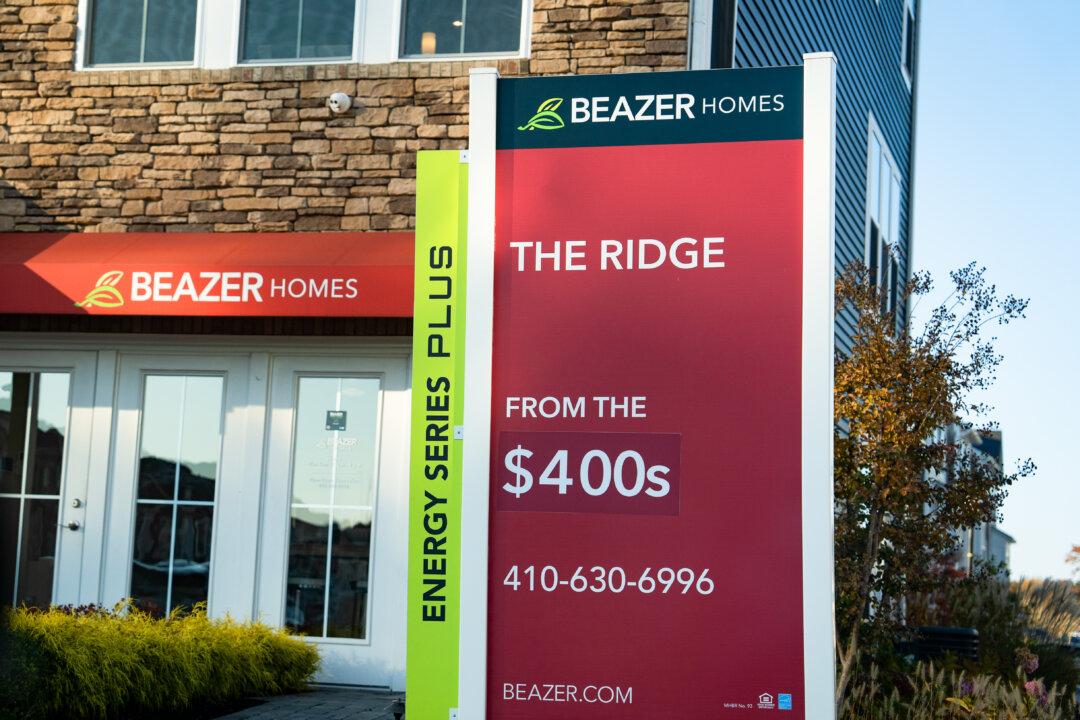Home prices in the United States have climbed to a record high following a nationwide supply shortage, according to real estate brokerage Redfin.
“The median U.S. home sale price rose 6.2 percent year over year in April to $433,558—the highest level on record,” said a May 17 Redfin press release. Even though the housing market at present is “much slower” than it was during the COVID-19 pandemic when there was a homebuying boom, prices continue to climb owing to a housing shortage. While new listings in April rose by 10.8 percent year over year, it was still around 20 percent below the pre-pandemic level.
This is mostly because many homeowners do not wish to sell as they feel “locked in” by the low mortgage rates they scored during the pandemic, the brokerage stated.
However, “it’s not all bad news for homebuyers,” said Redfin Economics Research Lead Chen Zhao. “In certain parts of the country, buyers also have room to negotiate as homes linger on the market, prompting sellers to slash their asking prices and provide concessions.”
Fernanda Kriese, a local Redfin Premier real estate agent, said that many sellers in Las Vegas were willing to negotiate a 5–10 percent reduction in the list price of homes for sale.
“Sellers are offering buyers money for mortgage-rate buydowns, along with other concessions. Homes that are listed below market value get multiple offers and are snatched up in two to four days, but homes that are priced $5,000 to $10,000 over market value are sitting for 30 to 60 days longer.”
Overall, 17.6 percent of homes for sale saw a price cut in April, up from 12.1 percent a year back. This was the “biggest gain in over a year,” the real estate brokerage noted.
According to the National Association of Realtors (NAR), over 90 percent of the 221 tracked metros posted home price gains in the first quarter of 2024. Thirty percent saw double-digit price gains, up from 15 percent in Q4, 2023.
At the same time, just seven percent of housing markets saw price declines in Q1, 2024, down from 14 percent in the fourth quarter of last year.
The home price growth in 90 percent of metro areas happened “despite facing the highest mortgage rates in two decades,” NAR Chief Economist Lawrence Yun pointed out.
“In the current market, rising prices are the direct result of insufficient housing supply not meeting the full demand.”
Affordability Woes
High home prices accompanied by elevated mortgage rates create a housing affordability crisis in the country. The 30-year fixed-rate mortgage was at 7.02 percent for the week ending May 16, up more than double from 3 percent roughly three years ago.Mortgage rates have declined over the past two weeks, which could “provide a bit more wiggle room in the budgets of prospective homebuyers,” said Sam Khater, Freddie Mac’s Chief Economist.
In a May 15 press release, the Mortgage Bankers Association (MBA) revealed that mortgage applications rose slightly by 0.5 percent from a week earlier. “The decline in rates led to a small boost to refinance applications, including another strong week for VA refinances,” said Joel Kan, MBA’s Vice President and Deputy Chief Economist.
“However, the overall level of refinance activity remains low. Purchase applications decreased, driven largely by a 9 percent drop in FHA (Federal Housing Administration) purchase applications. Conventional home purchase applications were down around one percent.”
“While the downward move in rates benefits prospective homebuyers, mortgage rates are still much higher than they were a year ago, while for-sale inventory remains tight.”
According to Redfin, only 20.6 percent (1 in 5) of new mortgages issued in 2023 went to low-income Americans, down from 23.2 percent in 2020. Only less than six percent went to very low-income Americans, down from 7.7 percent.
“Higher-income homebuyers are taking up the share of new mortgages that lower-income homebuyers have lost in the last several years,” the brokerage said.
“Nearly half (44.8 percent) of all new mortgages nationwide went to high-income buyers in 2023, bringing that group’s piece of the pie back up to almost exactly where it was in 2018. Their share dipped to a low of 41.2 percent in 2020.”
The monthly housing payment for a typical homebuyer is a “record-high” $2,886 per month, up from $1,500 in March 2019. Meanwhile, the typical downpayment for someone putting down 20 percent is now $84,000, again up from $56,800.
“There was a sweet spot in 2020 when mortgage rates were ultra-low and home prices had yet to skyrocket, allowing some lower-income Americans to break into the housing market,” said Redfin Senior Economist Elijah de la Campa.
“But somewhat ironically, the continued strength of the economy has made it harder to afford a home and widened the real-estate wealth gap between rich and poor Americans.”
Meanwhile, some buyers are choosing to purchase their dream home despite high rates, unwilling to risk even costlier purchases if they wait.
“High mortgage rates aren’t deterring buyers as much as they were last year; a lot of people want to get in now before prices go up more,” Miami Redfin agent Rachel Riva said in March.
“Buyers are lessening the impact of elevated rates in a few ways: Some are making high down payments to lower their monthly payments, and some are willing to take on a high rate now in hopes of refinancing when and if rates come down.”







